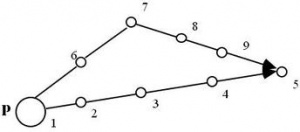Trajectory

Trajectory, a move path of a chess piece, a pawn, a king, a knight or a sliding piece from its origin square to a target square for attack or defense purposes, admissible in n plies, according to a plan. A trajectory of a sliding piece consists of so called alpha-squares, move target squares where the piece is not actually en prise, and empty beta-squares where the piece slides over, and which may be blocked as a defense.
Contents
Mathematical Projection
The concept of trajectories with the goal of winning material was formalized by Mikhail Botvinnik in the 60s. Introduced in 1966 at Moscow Central Chess Club [2] , with the skeptical Georgy Adelson-Velsky and others attending, he found Vladimir Butenko as supporter and collaborator, who first implemented the 15x15 vector attacks board representation on a M-20 computer, to determine trajectories. In Botvinnik's hierarchical Mathematical Projection (MP) of chess as a complex system, as apparently implemented in Pioneer, trajectories build the lowest level of the hierarchy. The concepts of zones as intermediate level of the MP consists of a network of main trajectories conform to attacking of defending plans determined elsewhere, negation trajectories, that is opponent's counter trajectories which may block or combat the primary trajectory in time, and own supporting counter-counter trajectories. The MP controls the growth of a search tree inside a best-first search, and prunes all branches forward which could not reach a goal in time.
Linguistic Geometry
Based on the research along with Botvinnik on the project Pioneer, Boris Stilman further formalized the mathematical projection as Linguistic Geometry with the Language of Trajectories, Languages of Trajectory Networks including the Language of Zones, and Languages of Searches including its sub-family, the Languages of Transitions [3].
See also
- All Shortest Paths
- Botvinnik-Markoff Extension
- Combination
- Connectivity
- Determining Trajectories
- Distance
- Fill Algorithms
- Interception
- Intersection Squares
- Moves
- Pioneer
- Progressive Mobility
- Réti Endgame Study
Publications
- Mikhail Botvinnik (1968). Algoritm igry v shakhmaty (The algorithm of chess)
- Mikhail Botvinnik (1970). Computers, Chess and Long-Range Planning. Springer-Verlag, New York [4] [5]
- Mikhail Botvinnik (1975). O Kiberneticheskoi Celi Igri. (On the Cybernetic Goal of Games), Soviet Radio, Moscow
- Mikhail Botvinnik (1979). O Reshenii Netochnih Prebornih Zadach. (On Solving Inexact Search Problems), Soviet Radio, Moscow
- Mikhail Botvinnik, Boris Stilman, Alexander Yudin, Alexander Reznitskiy, Michael Tsfasman (1980). Thinking of Man and Computer, Proc. of the Second International Meeting on Artificial Intelligence, pp. 1-9, Repino, Leningrad, Russia.
- Mikhail Botvinnik (1982). Decision Making and Computers. Advances in Computer Chess 3
- Mikhail Botvinnik (1982). Meine neuen Ideen zur Schachprogrammierung. Springer-Verlag, Berlin. amazon.de (German)
- Mikhail Botvinnik (1984). Computers in Chess: Solving Inexact Search Problems. Springer-Verlag, New York.
- Rudolf Huber (1990). Selektive visuelle Aufmersamkeit: Untersuchungen zum Erlernen von Fokustrajektorien durch neuronale Netze. Diplom thesis, Department of Computer Science, Technical University of Munich (German)
- Jürgen Schmidhuber, Rudolf Huber (1991). Learning to Generate Artificial Fovea Trajectories for Target Detection. International Journal of Neural Systems, Vol. 2, No. 1-2, pdf [6]
- Mikhail Botvinnik, Evgeniĭ Dmitrievich Cherevik, Vasily Vladimirov, Vitaly Vygodsky (1994). Solving Shannon's Problem: Ways and Means. Advances in Computer Chess 7
- Boris Stilman (1994). A Linguistic Geometry of the Chess Model. Advances in Computer Chess 7, pdf draft
- Boris Stilman (1995). Linguistic geometry: a new paradigm for intelligent systems. Proceedings of the 28th Hawaii International Conference on System Sciences (HICSS '95), pdf
- Boris Stilman (1995). Deep Search in Linguistic Geometry. Symposium on LINGUISTIC GEOMETRY AND SEMANTIC CONTROL, Proc. of the First World Congress on Intelligent Manufacturing: Processes and Systems, pp. 868-879, Mayaguez, Puerto Rico, CiteSeerX
- Vladimir Yakhnis, Boris Stilman (1995). Foundations of Linguistic Geometry: Complex Systems and Winning Strategies. Symposium on LINGUISTIC GEOMETRY AND SEMANTIC CONTROL, Proc. of the First World Congress on Intelligent Manufacturing: Processes and Systems, pp. 843-854,Mayaguez, Puerto Rico
- Richard Sutton, Andrew Barto (1998). Reinforcement Learning: An Introduction. MIT Press, Cambridge, Mass. ISBN 0-2621-9398-1. 9.6 Trajectory Sampling
- Boris Stilman (2000). Linguistic Geometry - From Search to Construction. (Operations Research/Computer Science Interfaces Series). Springer US, ISBN: 978-0-7923-7738-2, amazon.com, google books
- Diego Rasskin-Gutman (2009, 2012). Chess metaphors: artificial intelligence and the human mind. translated by Deborah Klosky, MIT Press
- Marko Maliković, Mirko Čubrilo (2010). Solving Shortest Proof Games by Generating Trajectories using Coq Proof Management System. Proceedings of 21st Central European Conference on Information and Intelligent Systems, Varaždin, Croatia [7]
Forum Posts
- Search extensions at promising trajectories by Reinhard Scharnagl, CCC, May 28, 2008
External Links
References
- ↑ from Boris Stilman (1994). A Linguistic Geometry of the Chess Model. Advances in Computer Chess 7, pdf draft, Figure 3
- ↑ The last day of the “Botvinnik Memorial” by Anna Burtasova, ChessBase News, September 07, 2011
- ↑ Boris Stilman (1994). A Linguistic Geometry of the Chess Model. Advances in Computer Chess 7, pdf draft
- ↑ Paul Rushton, Tony Marsland (1973). Current Chess Programs: A Summary of their Potential and Limitations. INFOR Journal of the Canadian Information Processing Society Vol. 11, No. 1, pdf
- ↑ Computers, Chess and Long-range Planning by Botvinnik by John L. Jerz
- ↑ Fovea centralis from Wikipedia
- ↑ Coq from Wikipedia